In this episode we’re going to look at the Melodic minor scale and its Modes. We’re using standard 8 string tuning: F#, B, E, A, D, G, B, E. Each mode pattern will be 3 notes per string.
Like the Harmonic minor scale the Melodic minor scale is a based on the Aeolian mode. The Aeolian mode, or Natural minor scale is the 6th mode of the Major scale. By raising both the 6th and 7th notes of the minor scale we get Melodic minor. You may also see this scale referred to as Jazz Minor. Let’s take a look at Melodic minor for 8 string guitar:
Turning Natural minor into Melodic Minor
In D minor the notes are:
D – E – F – G – A – Bb – C
We can convert this to D Melodic minor by raising the Bb and C to B and C#:
D – E – F – G – A – B – C#
In the diagram below you can see the notes of A Melodic minor and D melodic minor. Note that the 6th and 7th notes are a semitone higher than they would be in the Natural minor versions:
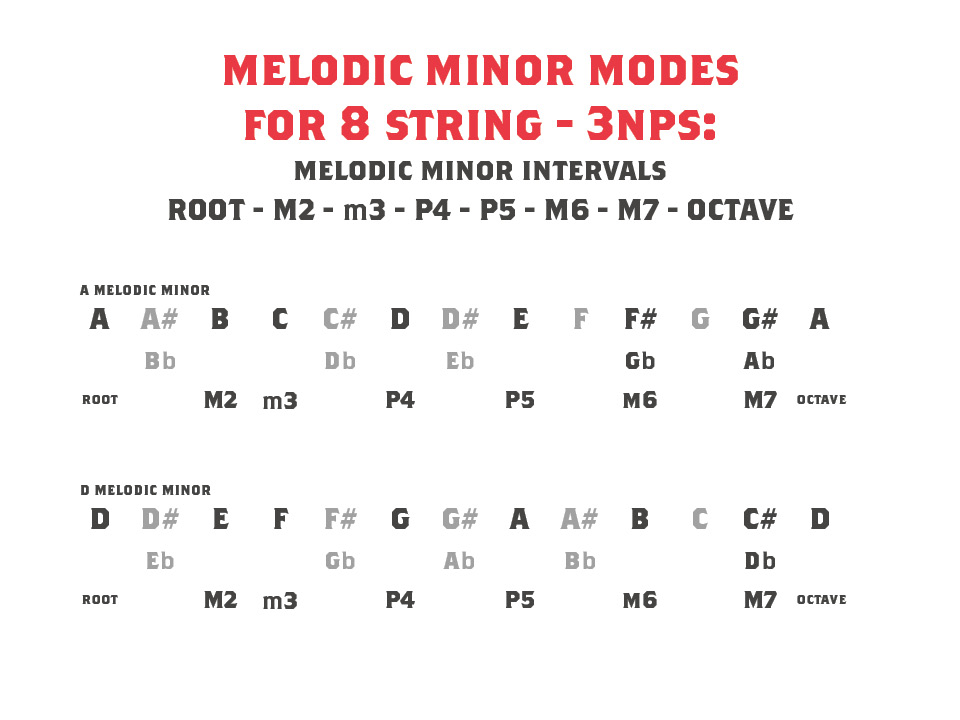
Interval Structure
As you can see the intervals used to create Melodic minor are:
Root – M2 – m3 – P4 – P5 – M6 – M7
M = Major
m = minor
P = Perfect (4th and 5ths are often referred to as perfect intervals unless they are diminished or augmented)
Let’s look at each 3 note per string mode shape and look at some of the main chords that each mode produces. We’ll use D Melodic minor and its modes as an example.
Melodic Minor for 8 string – Mode 1: Melodic minor
The Melodic minor mode is often used in Jazz and classical music but can be utilized in any genre. Traditionally melodies in Melodic minor were ascending only and natural minor was used for descending parts. In modern music the scale is often used both ascending and descending.
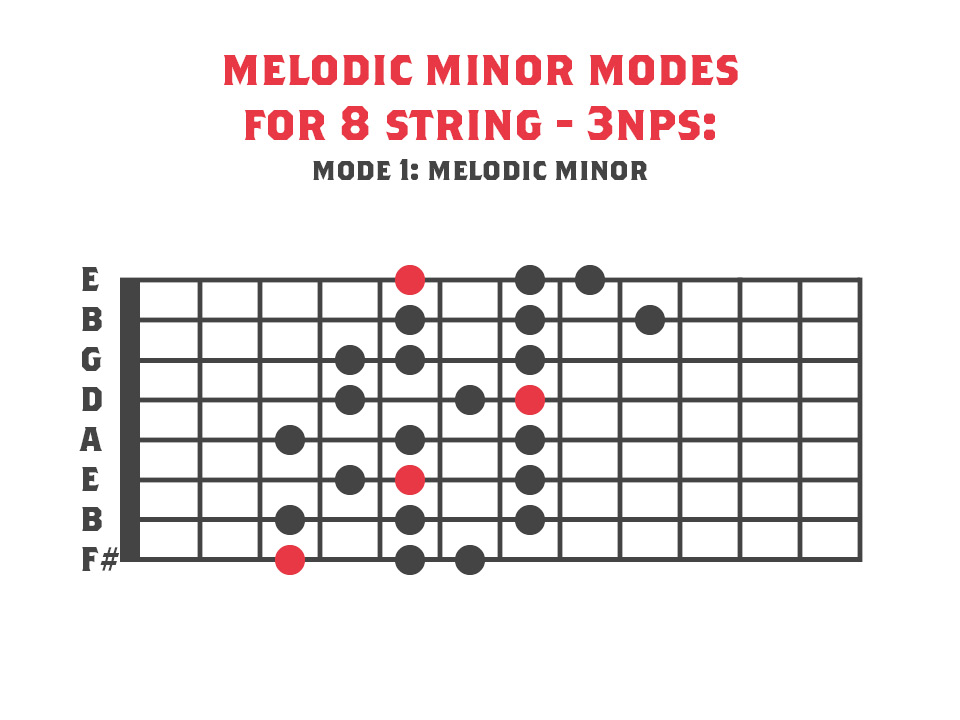
Remember, the red dots in the diagram represents the root note of the mode. If you play the above pattern with the red note on the 8th fret you get D Melodic minor. If you wanted B Melodic minor you could move the shape back so that the first note is at the 5th fret (Low F# string).
Like Harmonic minor the Chord usually associated with this mode is a minor chord triad and can be extended to a minor(Major7) chord. This is a minor triad with a Major 7th added. For example in D Melodic minor we would get:
Dm = D – F – A
Dm(Maj7) = D – F – A – C#
The minor(Major7) chord is similar to an Augmented chord and so has quite a mysterious sound, especially when played as an arpeggio. You can use this chord to create tension and then resolve to the minor triad.
Melodic Minor for 8 string – Mode 2: Dorian b2
As you can tell by the name this mode resembles Dorian but has a flattened 2nd note. This gives it a darker sound similar to Phrygian or Locrian.
In relation to D Melodic minor the notes would be:
E – F – G – A – B – C# – D
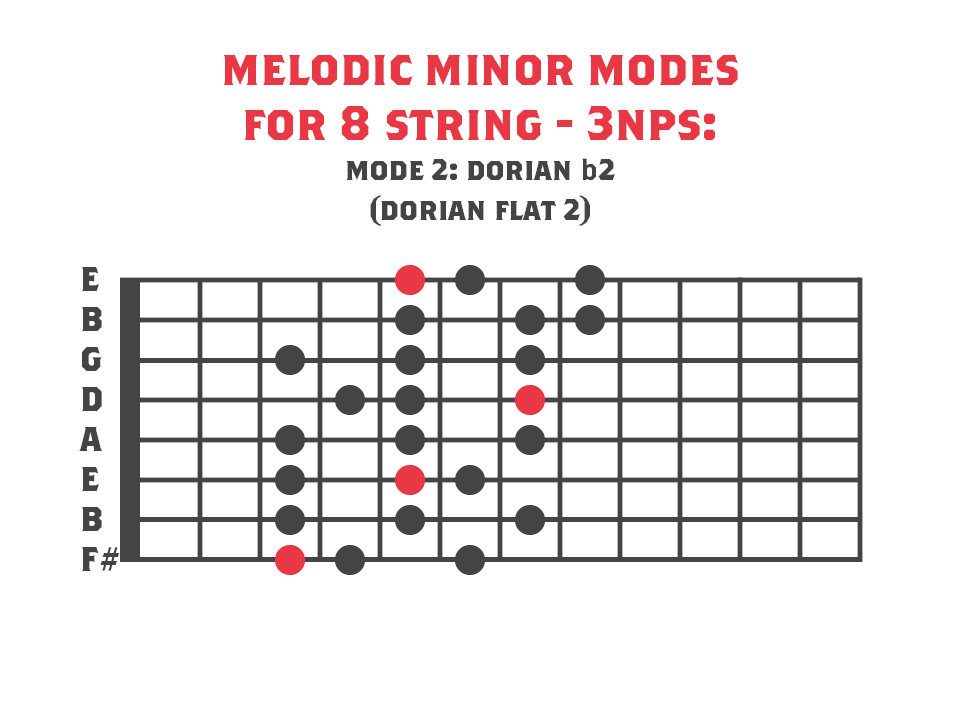
The chords built from the root of this mode would be (In E Dorian b2) Em and Em7:
E minor = E – G – B
E minor 7 = E – G – B – D
Melodic Minor for 8 string – Mode 3: Lydian #5
Sometimes called Lydian Augmented this is the 3rd mode of Melodic minor. In D melodic minor this gives us F Lydian #5. As I’m sure you can imagine this is the same as Lydian but with an Augmented Fifth (No Sh*t Sherlock!).
In F Lydian #5 the notes would be:
F – G – A – B – C# – D – E
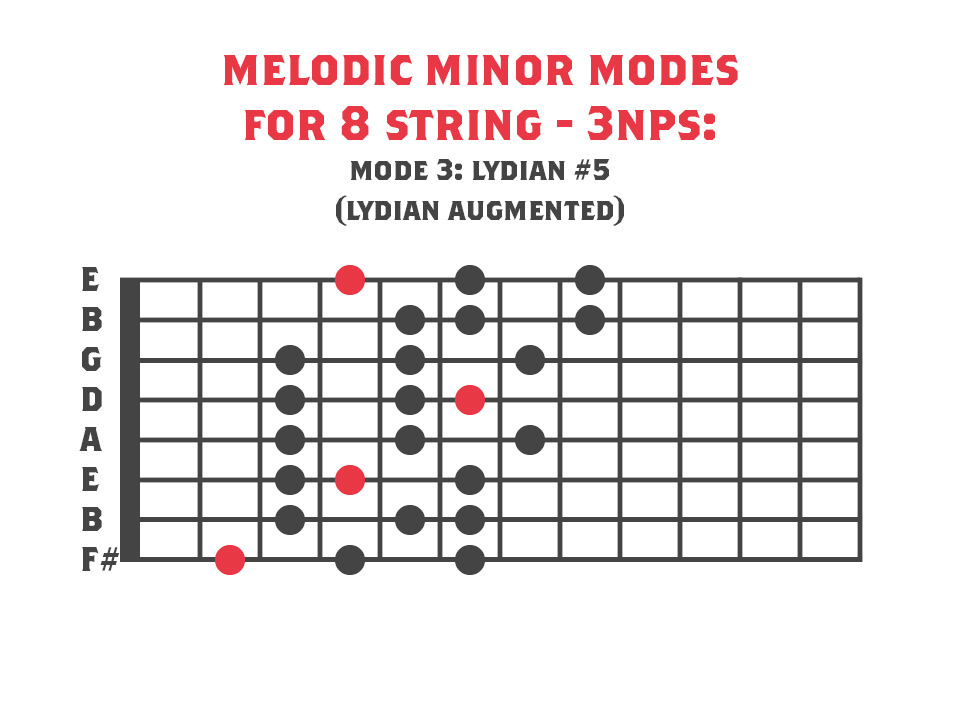
The chord we get from this is also pretty self explanatory… an Augmented chord. If we add the seventh we get an Augmented Major 7 or you can call it a Major 7 (#5):
F+ = F – A – C#
FMaj7(#5) = F – A – C# – E
Melodic Minor for 8 string – Mode 4: Overtone Scale
The 4th mode is the Overtone scale, also called Lydian Dominant. This one looks a bit like Lydian (duh!) but with a m7 instead of a Maj7.
If we again use D Melodic minor as our parent scale then this would give us the G Overtone scale for our 4th mode. The notes would be:
G – A – B – C# – D – E – F
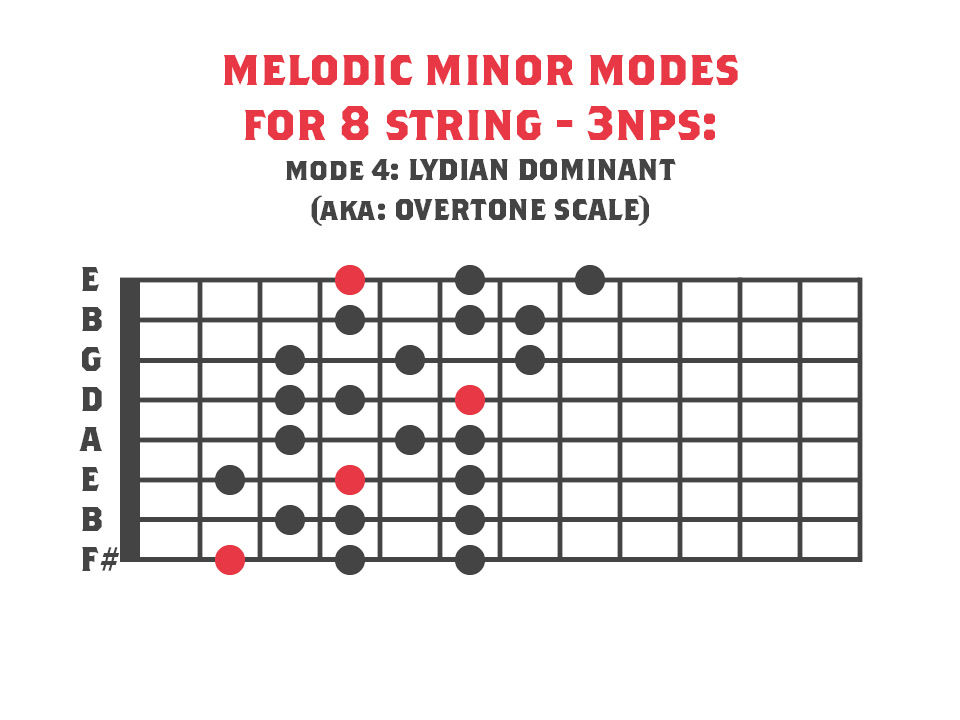
This mode has a Major chord triad based on the root. By adding the seventh we get a Dominant 7 chord. If you want to try something fancy we can also add in that C# giving us G7(#11):
GMaj = G – B – D
G7 = G – B – D – F
G7(#11) = G – B – D – F – C#
Melodic Minor for 8 string – Mode 5: Mixolydian Flat 6
If you know the mixolydian mode then this is another fairly obvious alteration. We’re simple moving the 6th note of the mode back 1 fret. For example in A Mixolydian, the 6th note is F# so we flatten this to F to get A Mixolydian b6:
A – B – C# – D – E – F – G
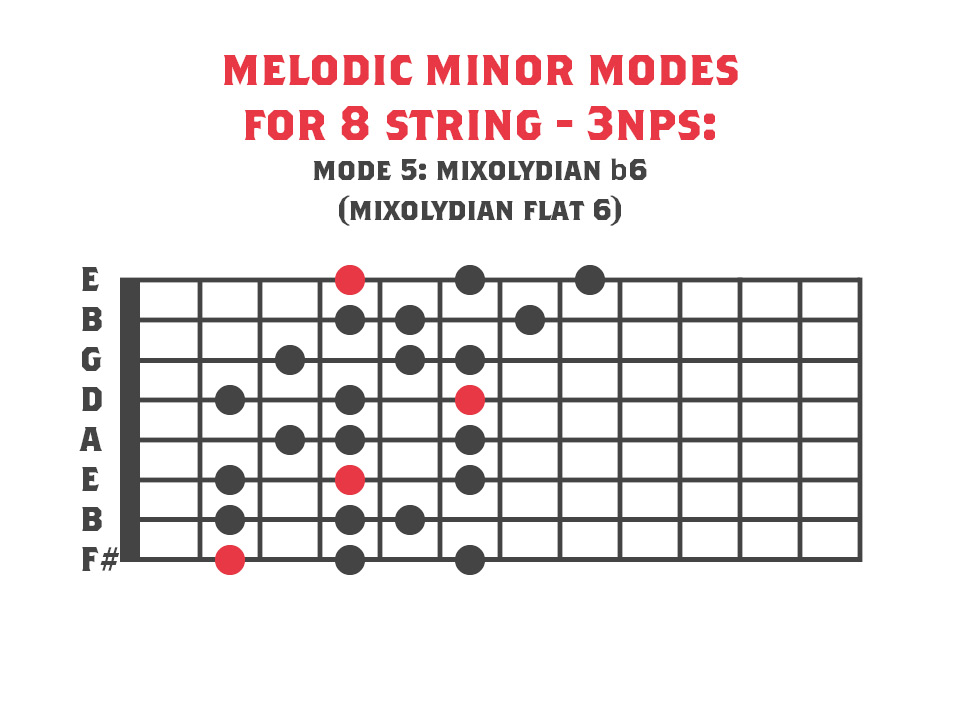
Similar to the Mixolydian mode we can derive a Major chord triad and a Dominant 7 chord from this mode. However if we add a b6th (Or b13th) we end up with some extra tension. For example we could play an A7(b13) chord. This can be used to set up a key change as it resolves nicely to a D Major chord.
AMaj = A – C# – E
A7 = A – C# – E – G
A7(b13) = A – C# – E – G – F
Melodic Minor for 8 string – Mode 6: Aeolian Flat 5
By now you’re probably getting the idea of naming these by their Major scale mode counterparts with alterations. Here we have a mode that is similar to the Natural minor scale (Aeolian mode) but with a flat 5th. When you flatten a Perfect 5th interval you get a Diminished 5th. This gives the mode a dark sound and can be great for heavier music.
In D Melodic minor the Fifth mode would be B Aeolian b5. The notes would be:
B – C# – D – E – F – G – A
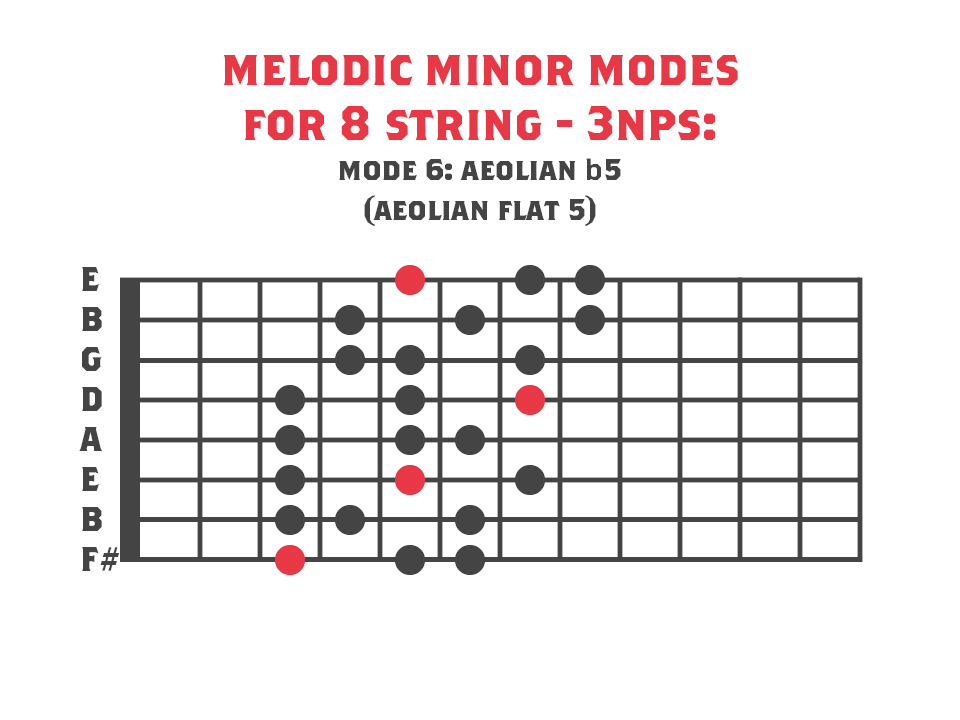
From this mode we can build a diminished chord or a minor 7 flat 5 chord. This chord has a lot of tension and is often used as a passing chord. Again we could use this as an opportunity to change key since Bdim and Bm7b5 both resolve well to C Major.
Bdim = B – D – F
Bm7b5 = B – D – F – A
Melodic Minor for 8 string – Mode 7: Super Locrian
The Altered scale, or Super Locrian contains a diminished 4th interval. This is the same pitch as a Major 3rd so in a way the Mode has both a minor 3rd and a Major 3rd. This mode has a dark and mysterious quality to it.
Based on D Melodic Minor the seventh Mode would be C# Super Locrian and the notes would be:
C# – D – E – F – G – A – B
Remember that by understanding the intervals between these notes you can work them out from any root note. The same goes for every Mode we’ve looked at.
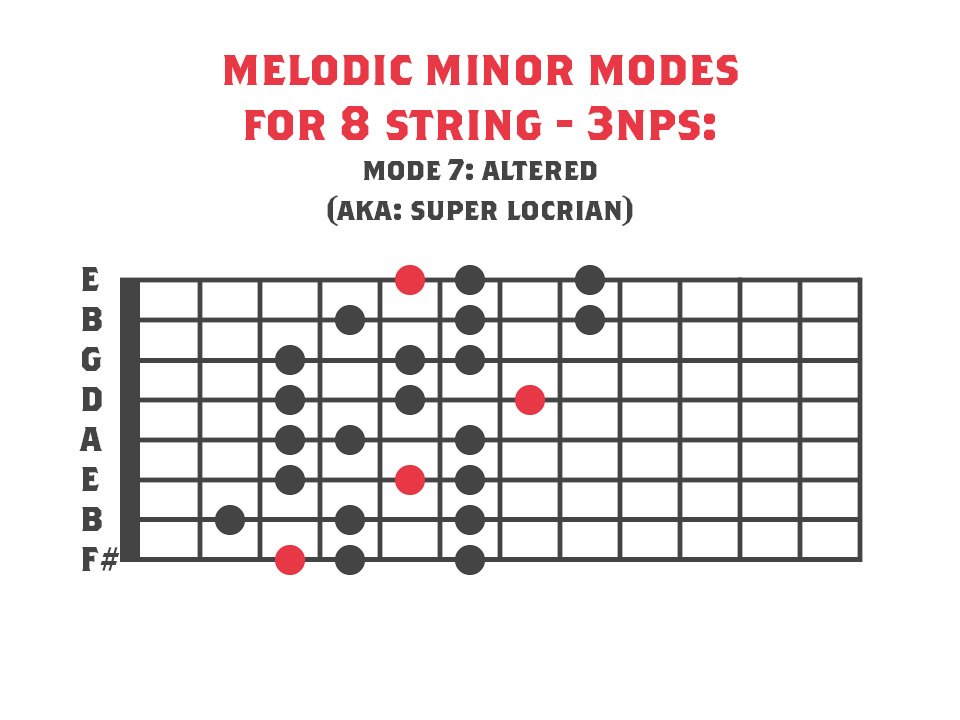
With this mode we can also get a diminished chord and by adding the seventh note we get a minor 7 flat 5 chord. Since the flat 4th is the same pitch as a Major 3rd we can also play a 7b5 chord. You could also experiment with adding in the flat 9 for an extra dark sound.
C#dim = C# – E – G
C#m7b5 = C# – E – G – B
Db7b5 = Db – F – G – B
(I have named the chord Db rather than C# to imply F is being used as the Major 3rd rather than a flat 4th.)
That’s the seven modes of Melodic minor for 8 string guitar! We’ve looked at examples in D Melodic minor so try them out in different keys too!
For more on modes check out our posts on Melodic minor for 6 string, 7 string and 3 Octave modes. Also check out the Major scale modes starting here.

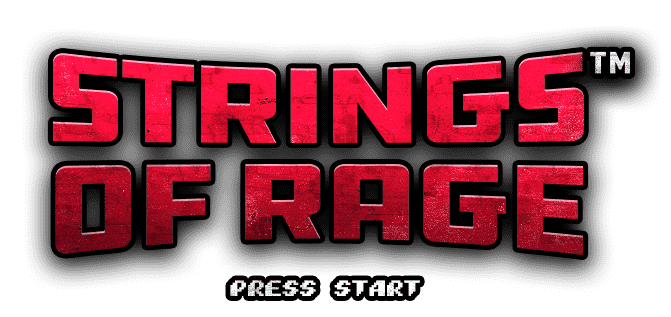

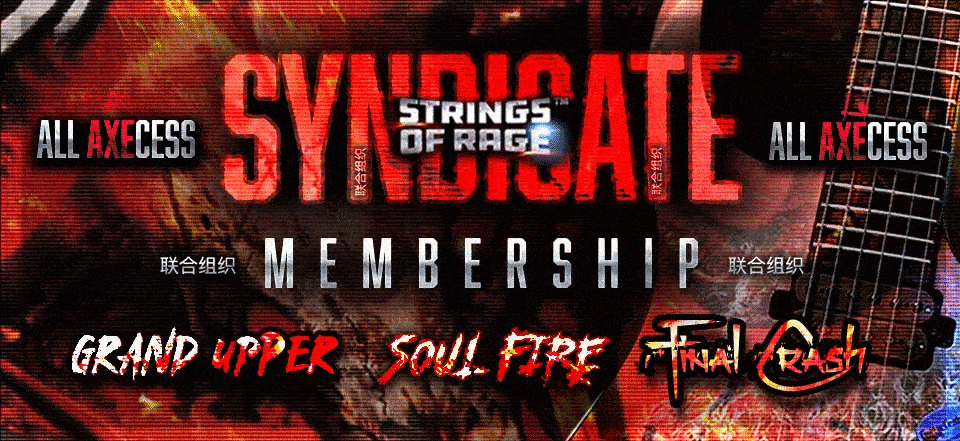
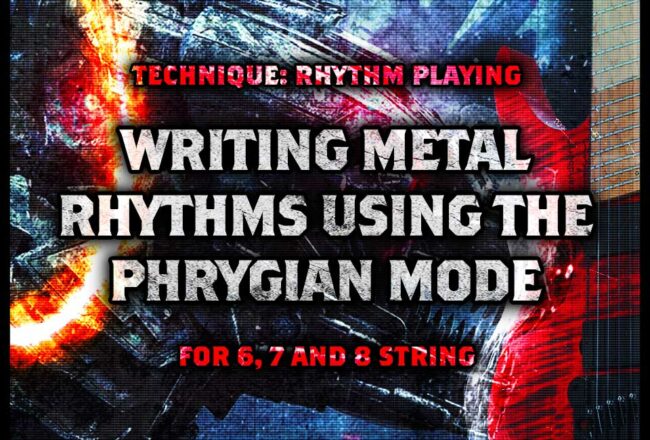








No Comment